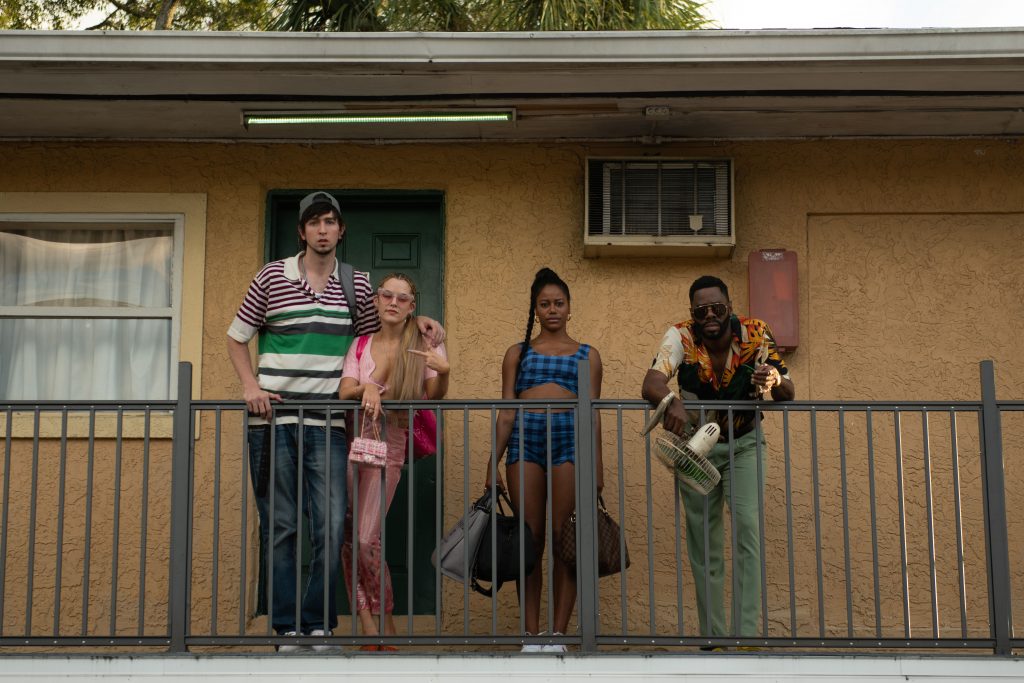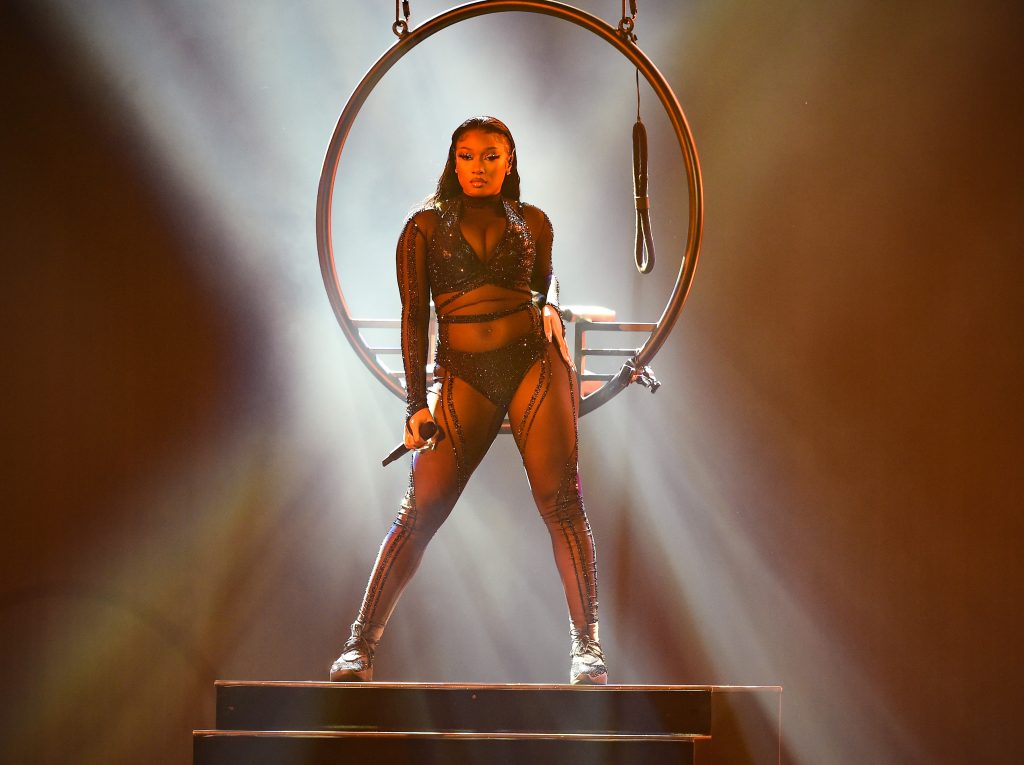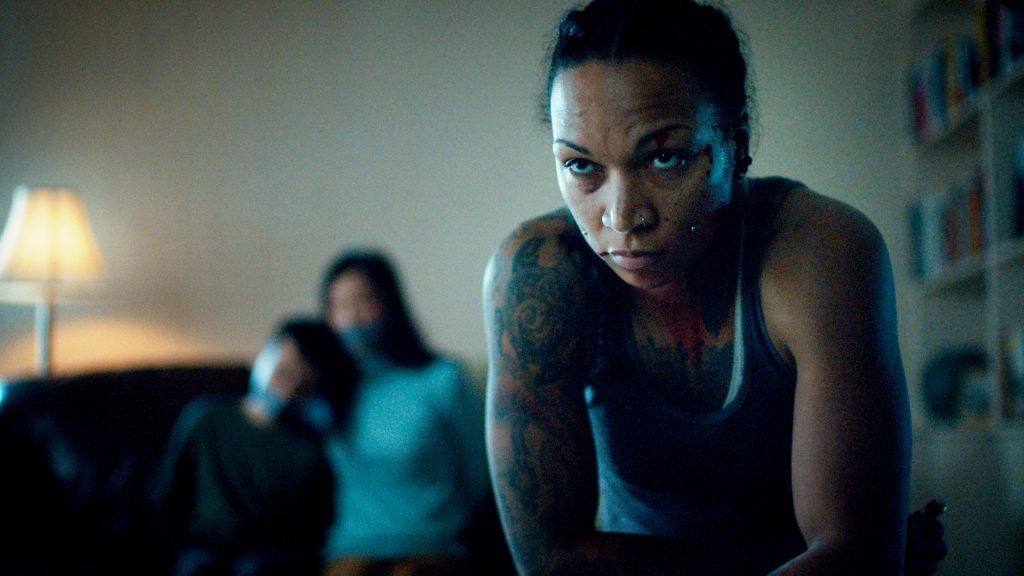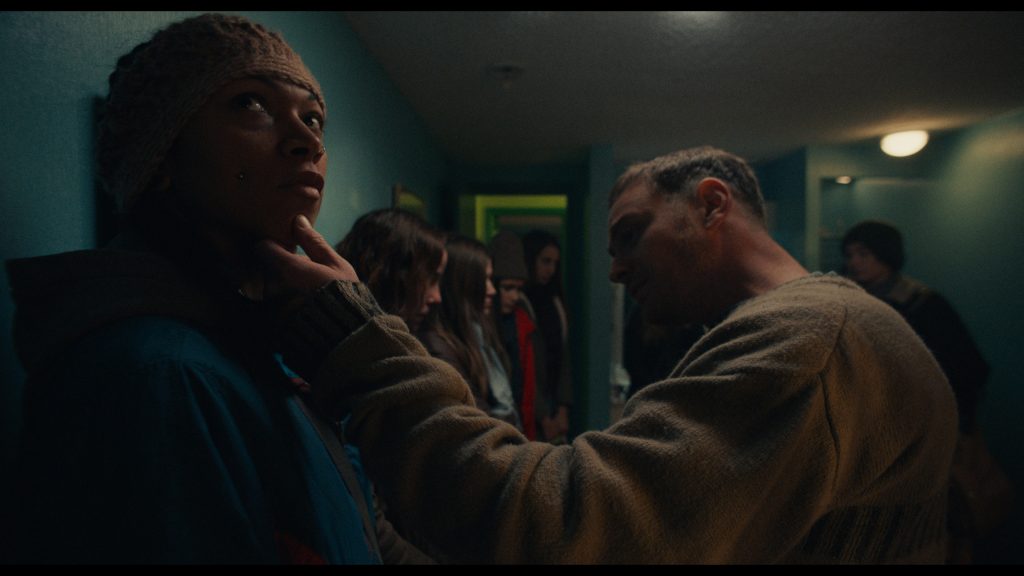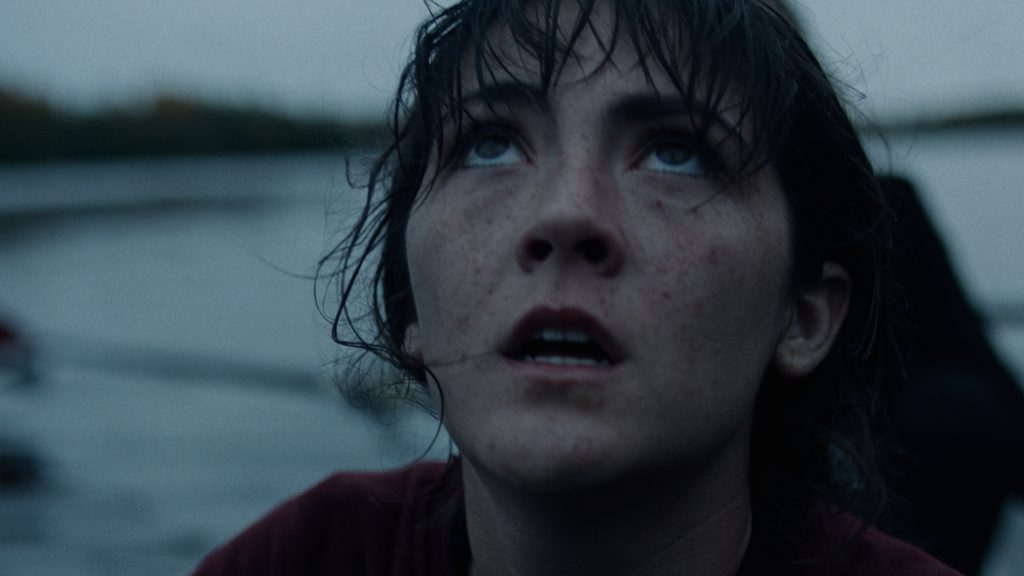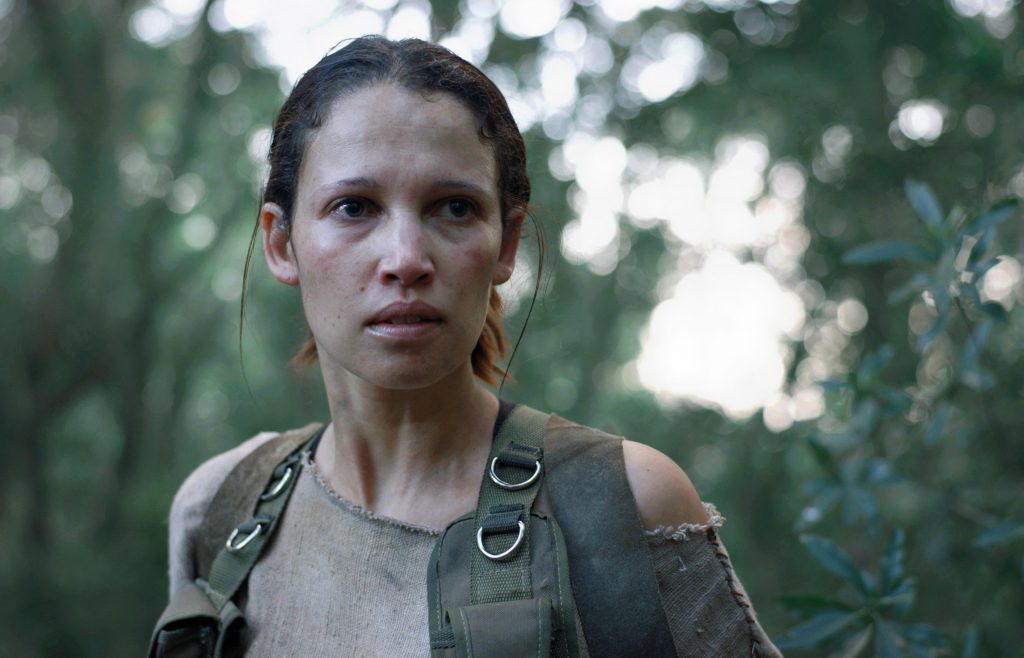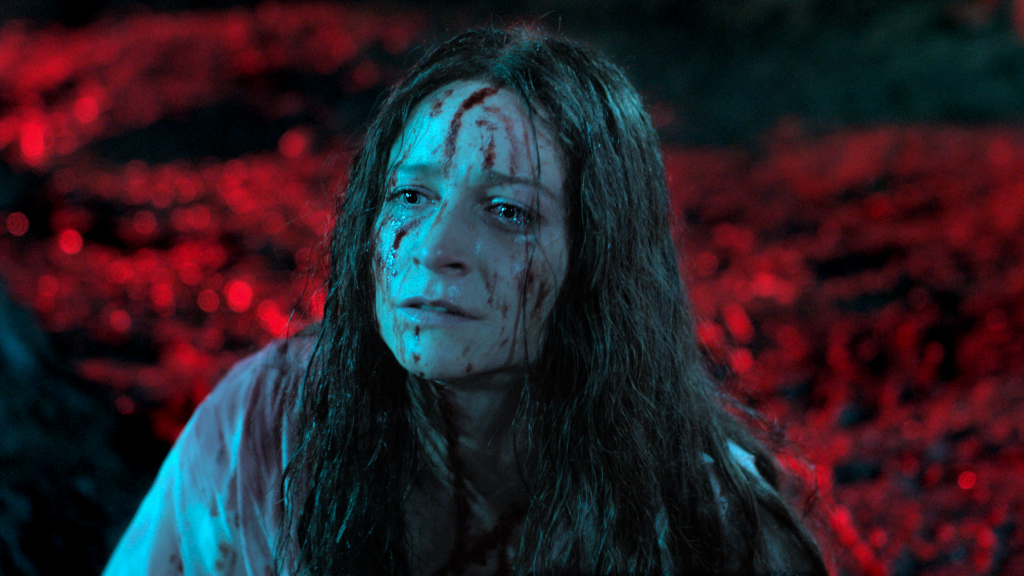June 29, 2021
by Carla Hay

Directed by Cate Shortland
Culture Representation: Taking place in Norway and Russia and briefly in Ohio, Hungary and Morocco, the superhero action film “Black Widow” features a predominantly white cast of characters (with a few black people and Asians) representing heroes, villains and people who are in between.
Culture Clash: Russian American superhero Natasha Romanoff, also known as Black Widow, battles an evil nemesis from her past named Dreykov, who has sent an assassin named Taskmaster to kill anyone who gets in the way of Dreykov’s goal of world domination through mind control.
Culture Audience: “Black Widow” will appeal primarily to people who already know a lot about what’s going on in the Marvel Cinematic Universe.

If you’re not familiar with the Marvel Cinematic Universe (MCU), then “Black Widow” might be too confusing for long stretches of the movie. For everyone else, “Black Widow” offers a satisfactory but not particularly outstanding chapter to the MCU. The best parts of the movie are the scenes showing the interpersonal dynamics between an estranged foster family that reunites, because the movie’s visual effects and villains aren’t as compelling as other MCU movies with the Black Widow character.
Directed by Cate Shortland and written by Eric Pearson, “Black Widow” takes place primarily in 2016, in the period of time between 2016’s “Captain America: Civil War” and 2018’s “Avengers: Infinity War.” Viewers who haven’t seen or don’t know anything about “Captain America: Civil War” before seeing “Black Widow” will feel like they’ve stepped into a world that has passed them by, because there are several key plot developments in “Captain America: Civil War” that are necessary to know in order to fully appreciate “Black Widow.”
“Black Widow” is strictly a movie for MCU fans, because it assumes that people watching this movie know about have or have seen “Captain America: Civil War” and the other MCU movies leading up to it. “Black Widow” is not the movie for you if you don’t know the answers to these questions before watching the movie: “What is S.H.I.E.L.D.?” “What is Hydra?” “Who else is in the Avengers?”
Likewise, if you don’t know that Avengers superhero Black Widow, also known as Natasha Romanoff (played by Scarlett Johansson), died at the end of 2019’s “Avengers: Endgame” (it’s really not spoiler information at this point), then the end-credits scene in “Black Widow” won’t make much sense. Julia Louis-Dreyfus is in the “Black Widow” end-credits scene, which makes a direct reference to Black Widow’s death and who Black Widow was with when she died, because it’s a likely revenge plot for a Marvel series on Disney+ or a MCU sequel. The “Black Widow” end-credits scene takes place at the gravestone of Natasha Romanoff, so anyone who sees “Black Widow” who didn’t know that she died will have that part of “Avengers: Endgame” spoiled for them.
If you know absolutely nothing about the MCU and Black Widow (whose first MCU appearance was in 2010’s “Iron Man 2”), then here’s what “Black Widow” does fairly well: It shows more of her backstory, in terms of how she was raised at a certain point in her childhood and why she got separated from her biological family and her foster family. The highlights of “Black Widow” are what happens when she reunites with the foster family she had for three years when she was a child.
Each of these family members has gone on to be involved in shady dealings of the Russian government. It’s an often-contentious, sometimes poignant and occasionally humorous reunion. Their up-and-down interactions speak to the love/hate feelings that people have for past or present loved ones. And that’s the humanity that makes “Black Widow” more than just a bunch of action scenes in a big-budget superhero movie.
“Black Widow” opens with a scene taking place in Ohio in 1995. Alexei Shostakov (played by David Harbour) and Melina Vostokoff (played by Rachel Weisz) are a Russian immigrant couple raising two girls on a rural farm. The older girl, who’s 11 years old, is a young Natasha Romanoff (played by Ever Anderson), while the younger girl is Yelena Belova (played by Violet McGraw), who’s 6 years old. Why do they all have different last names? Because they’re not biologically related to each other, but they have been living together as a family for three years.
Life seems to be “normal” for this makeshift family when a day comes that the Alexei and Melina have been dreading: The family will be separated by the Russian government. Some military-looking operatives invade the home one night, but Alexei and Melina have already planned their escape. Melina pilots a small plane with Natasha and Yelena as the passengers, while Alexei tries to keep the home invaders away from the plane, by shooting at the invaders with a rifle.
The plan to escape ultimately fails. Melina is shot but not gravely wounded. A terrified but quick-thinking Natasha takes over in piloting the plane. However, this family of four eventually couldn’t evade caputure, even though Natasha pulls a gun on the military men tasked with separating the family. Alexei hands over a mysterious computer disc to a man named General Dreykov (played by Ray Winstone), who is the one in charge of this home invasion. Meanwhile, the girls are drugged and taken away from the only parents they’ve known up to this point.
The movie then fast forwards to 2016. Natasha is in Norway, and is now a fugitive running from U.S. general Thaddeus Ross (played by William Hurt), because she’s has been accused of assaulting the king of Wakanda. (That’s a reference to the African nation of “Black Panther,” in case you didn’t know.) Natasha is also in violation of the Sokovia Accords, a set of regulations for people with superpowers, especially people working for government agencies. Steve Rogers, also known as Captain America, is also a fugitive, although he does not make an appearance in this “Black Widow” movie.
Natasha has been hiding out in a trailer somewhere in rural Norway. Several times in the movie, Natasha will make a reference to the falling out that the superhero group the Avengers had in “Captain America: Civil War.” As her trusted friend Mason (played by O-T Fagbenle) tells her as he hands her a stack of fake IDs to use, “I hear the Avengers are getting divorced.” Any viewers expecting any of the other Avengers to make a surprise appearance in “Black Widow” will be disappointed. Mason also gives Natasha a box of unopened mail that he says came from the Budapest safe house where she previously stayed.
“Black Widow” follows the typical superhero movie trope of a villain wanting to gain possession of an object that will help the villain take over the world. In this movie, it’s explained in a somewhat convoluted way that Dreykov and his cronies have been capturing female orphans and other vulnerable girls. The captured girls are held in a Red Room torture facility in Russia, where the girls are forced to be in a spy program.
In the Red Room, the victims undergo chemical treatments that alter their brain and allow Dreykov to have mind control over them. All of the victims’ reproduction organs are removed, and they grow up to become trained assassins called Widows, who do Dreykov’s bidding. Depending on how much their brains have been manipulated, the Widows have varying degress of memories of their lives before the Red Room.
Natasha and Yelena both spent time in the Red Room, but the movie has no flashbacks to this painful period of time in their lives. However, it’s revealed in conversations that Natasha was brainwashed but able to escape from the Red Room and never underwent the chemical treatments to the brain. Natasha’s spy life in America eventually led her to join the Avengers. Yelena wasn’t so lucky: She got the Red Room’s brain altering chemical treatment, which leaves her vulnerable to Dreykov’s mind control.
It’s why Yelena is seen in Morocco fighting an operative named Oksana (played by Michelle Lee), who is stabbed by Yelena in an outdoor street battle. Before Oksana dies, she takes a capsule and sprays Yelena with a mysterious red gas. Yelena seems to come out of a trance, and Yelena is soon reported as a deserter. It’s later revealed that this red gas is an antidote to Dreykov’s mind control. And that’s why he wants to get all of this antidote that exists in the world.
Somehow, Natasha has a stash of this antidote, so Dreykov sends a mysterious assassin named the Taskmaster after her to get this stash. The Taskmaster is completely covered in armor and doesn’t speak. Therefore, viewers will be guessing who’s really inside the armor. Is it a human being? A robot? Something else? The identity of the Taskmaster is eventually revealed in the last third of the movie.
Because Natasha currently feels all alone in the world, her emotions are raw when she has a tension-filled reunion with an adult Yelena (played Florence Pugh) when they see each other at that safehouse in Budapest. They have a big brawl that leads to an uneasy truce when they find out that they both want to get revenge on Dreykov because he separated their family. Natasha and Yelena also want to defeat Dreykov because they want to stop what’s going on in the Red Room.
Up until Natasha and Yelena reunited, Natasha assumed that Natasha had killed Dreykov in a building explosion that Natasha caused shortly before she joined S.H.I.E.L.D. (S.H.I.E.L.D. is an acronym for the spy/counter-intelligence/superhero-affiliated agency Strategic Homeland Intervention, Enforcement and Logistics Division.) But when Yelena asks Natasha if she actually saw Dreykov’s dead body, Natasha replies, “There was no body left to check.”
Dreykov’s daughter Antonia (played by Ryan Kiera), who was about 9 or 10 years old at the time, was also in the building when it exploded. And that’s why Dreykov has an extra-personal grudge against Natasha. A flashback scene shows that Natasha knew that Antonia was in the building when Natasha gave the go-ahead for the building to be detonated. The way Natasha describes it to Yelena, Antonia was “collateral damage.”
This cold and calculating side to Natasha is frequently displayed in the story to contrast with Yelena being hotheaded and impulsive. If Yelena is like fire, then Natasha is like ice. The personality differences between these two women can result in their frequent conflicts with each other. But other times, the contrasts between Yelena and Natasha can work to their benefit when they have to team up for a shared goal.
And even though these two women haven’t lived as sisters in 16 years, there’s still some leftover sibling rivalry. Yelena calls Natasha a “poser” because of the crouching stance that Black Widow is known for before she goes in on an attack. Yelena also mocks the way that Natasha whips her hair around during a fight, as if she’s doing a photo shoot. This “poser” insult becomes a recurring joke in the movie.
There’s also a tinge of jealousy in Yelena’s teasing of Natasha. At one point in the movie, Yelena says in an envious tone to Natasha: “We are both trained killers, except I’m not the one on the cover of a magazine. I’m not the killer that little girls call their hero.”
In another part of the conversation, Yelena explains the differences between what she experienced in the Red Room and what Natasha experienced: “What you experienced was psychological conditioning. [With what I experienced], I’m talking about chemically altering brain functions—they’re two completely different things.” Yelena says what it feels like to have the chemical alterations to the brain: “You’re fully conscious but you don’t know which part is you.”
Natasha is the one who brings up the idea of going to the Red Room and killing Dreykov once and for all. Yelena replies, “That sounds like a shitload of work.” Natasha says with a smirk, “It could be fun though.”
And where have Alexei and Melina been since they last saw Natasha and Yelena? Alexei has been in a Russian gulag, where he has been fuming over all the glory and notoriety that Captain America has gotten all over the world. That’s because Alexei has a superhero alter ego named Red Guardian, whose superhero career was cut short when Dreykov betrayed Alexei and made sure that Alexei was sent to prison. Needless to say, Alexei is very bitter about it.
Melina has being working as a scientist, so those skills come in handy when Melina, Alexei, Natasha and Yelena eventually reunite. This “family reunion” is not a surprise, since it’s been in “Black Widow” trailers and is a big selling point for the movie. The initial awkwardness of the reunion—and some of the sarcastic wisecracks that ensue—bring much of the movie’s comic relief.
“Black Widow” has the expected high-energy chase and fight scenes, including a far-fetched sequence of Natasha and Yelena helping Alexei escape from prison. The movie’s visual effects are hit and miss. There’s a big action sequence that takes place in the snow that is one of the standouts. But there are a few scenes that involve explosions where the fire looks too fake.
Even though Black Widow is a superhero, she’s not immune to getting fire burns. And yet, there are too many moments where she’s right in the thick of explosions, and she doesn’t get the serious fire burns that someone would get in real life. Some of the movie’s more dramatic scenes have cinematography that’s drenched in psychedelic red, which viewers will either think looks great or annoying.
Alexei and Melina are kind of like the MCU version of “The Honeymooners” couple Ralph Kramden and Alice Kramden. Alexei is a lot of bluster and ego, while Melina is his “been there, done that” calmer counterpart. There’s a comedic scene where Alexei tries to impress his reunited family, by putting on his old Red Guardian costume, but due to his weight gain since he last wore it, he has a hard time fitting into the costume.
On a more serious note, there’s a scene with Alexei, Natasha and Yelena in a heliocopter where Alexei makes a crude comment to Yelena by asking her if she’s being so uptight because she’s menstruating. Yelena reminds Alexei that she doesn’t menstruate because her reproductive organs were removed in the Red Room. Yelena then gives a detailed description of what reproductive organs were removed, until a very uncomfortable Alexei tells them to stop talking about it. Yelena then says impishly that she was just about to talk about fallopian tubes.
Although this scene has a sarcastic tone to it, it’s a not-so-subtle commentary on the gender politics that are part of this movie’s storyline. The Red Room is an obvious metaphor for a toxic patriarchy where a male villain is responsible for literally ripping away reproductive rights. And throughout “Black Widow,” the women are the ones who make the best and bravest decisions. Alexei has his heroic moments too, but he’s often outsmarted and outshined by the women in his life.
And if weren’t obvious enough in the movie’s trailers, there’s no doubt when watching all of “Black Widow” that this movie is a launching pad for Yelena, who’s clearly going to be a big part of the MCU. Pugh tends to be a scene stealer in all of her movies, and “Black Widow” is no exception, since Yelena brings a lot of relatable strengths and flaws to this character. Johansson’s Natasha/Black Widow is the ice queen in charge, but some of her emotional ice is melted in effective scenes where she finds out the truth about her biological family and how she ended up in the Red Room.
Most of the actors depicting the characters who are supposed to have Russian accents aren’t actually Russian in real life. Johansson and Harbour are American, while Pugh, Weisz and Winstone are British. Ukrainian French actress Olga Kurylenko is in the movie, but she’s in a role that is supposed to be among the plot twists. Out of all the non-Russian actors who have Russian accents in the movie, most are good but not excellent at sounding Russian, except for Winstone who definitely needed more Russian dialect training.
Shortland’s direction of “Black Widow” strikes a mostly well-paced balance between action, drama and touches of comedy. The movie’s biggest flaws are in how little regard it has for viewers who might be new to the MCU and who will have no idea what the characters are talking about for a great deal of “Black Widow.” In other words, “Black Widow” is definitely not a stand-alone MCU movie. Just like a web that a black widow spider can weave, the movie’s a little too tangled up in other MCU storylines and is best enjoyed by people who’ve already seen most if not all the other MCU movies that have Black Widow.
Disney’s Marvel Studios will release “Black Widow” in U.S. cinemas and at a premium extra cost on Disney+ on July 9, 2021.


